Article from TNU JUNE 2024
CRUISING JUNE 2024
Now for something completely different! Plus Hebridean Princess.
If you enjoy cruising as a means of getting away for a truly relaxing waterborne touring holiday with everything included but are alarmed by the sheer size of some of the offerings now available why not try something still maritime but at the other end of the spectrum. And stay in British waters with a crew whose first language is English, and a cruise with a Scottish twist. Lord of the Highlands might be just for you.
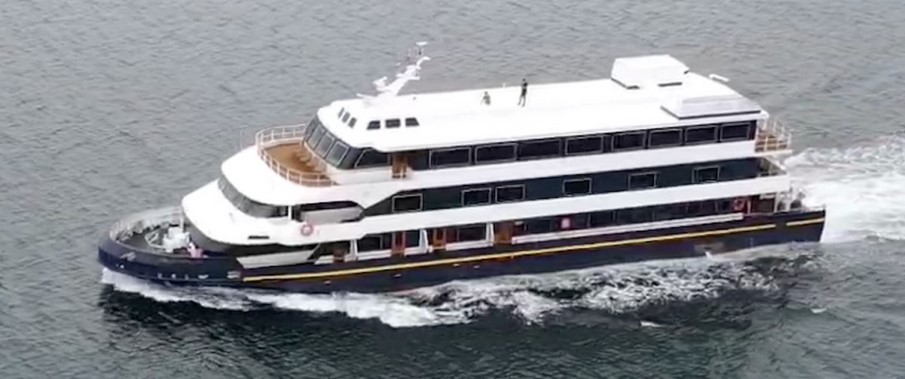
Lord of the Highlands is happy in Loch Ness, and also what is is in fact The Atlantic, and the Scotish Western Isles
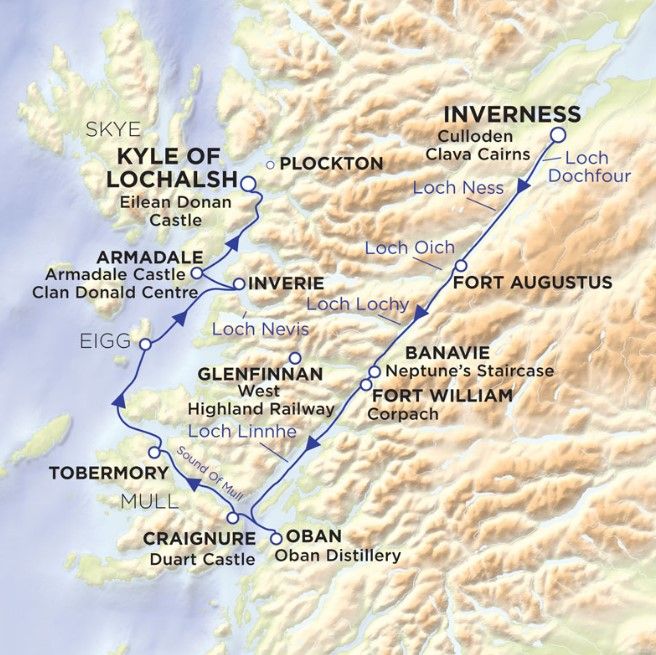 Malcolm Ginsberg reports on what turned out to be a week-long exceptional and most enjoyable experience.
Malcolm Ginsberg reports on what turned out to be a week-long exceptional and most enjoyable experience.
Lord of the Highlands was acquired by Hebridean Island Cruises in 2023 and is now into its second season. Based in Inverness, sometimes venturing as far south as Edinburgh, it more often than not spends its time traversing Loch Ness and the remarkable Caledonian Canal lock system, and out into the Western Isles via Fort William and Oban. At just 150ft long and with a maximum of 38 guests, it is a travelling house party with a very mixed eclectic guest list.
Our journey started at Inverness, capital of the Highlands. Direct access is by road, train from as far afield as London, perhaps by the Caledonian Sleeper, or by air from Amsterdam, Bristol, Gatwick, Heathrow, Luton and Manchester airports. Hebridean then brings together guests at the Kingsmills Hotel on the outskirts of the city. We are met by our on-board guide, James Walker, he of Aberdeen, a born raconteur, knowledgeable of all things Highland in the Highlands.
The Captain of the Lord of the Highlands was Duncan McNiven, experienced in these waters, assisted by William Rendel, another Scot. The ship’s Hotel Manager, Kirsty Butler from New Zealand, has been with the company seven years.
Lord of the Highlands was moored at the Muirtown Locks on the Caledonian Canal. More anon. She has only three guest decks and is the perfect layout. There is no elevator on board, the decks being connected by two short staircases with handrails on both sides.
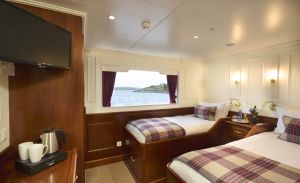 The décor can be best described as traditional, mainly dark teak, with light fabrics in the dining room and lounge. It is the same for the cabins, twin beds for the most part, with en-suite facilities including a glass enclosed shower. Cabin service can be provided but that is not really necessary. For reasons best known to the ship designers the beds are set high, presumably to allow large portmanteaus to be stored underneath. A stool can be provided for those less able. There is ample storage space and wi-fi in the cabin. There is of course a turndown service. Tea and coffee making facilities are in the room, though if you want to join fellow travellers in the lounge area you can help yourself there, or the serving staff are happy to do it for you. And when I say happy, I really mean it, they are smiling all the time.
The décor can be best described as traditional, mainly dark teak, with light fabrics in the dining room and lounge. It is the same for the cabins, twin beds for the most part, with en-suite facilities including a glass enclosed shower. Cabin service can be provided but that is not really necessary. For reasons best known to the ship designers the beds are set high, presumably to allow large portmanteaus to be stored underneath. A stool can be provided for those less able. There is ample storage space and wi-fi in the cabin. There is of course a turndown service. Tea and coffee making facilities are in the room, though if you want to join fellow travellers in the lounge area you can help yourself there, or the serving staff are happy to do it for you. And when I say happy, I really mean it, they are smiling all the time.
Called the John Buchan, and named after the distinguished Scottish writer, you board on the lowest deck, which includes four cabins with large balconies, staff areas and the kitchen.
Next up is the Richard Hanny deck, taking its name from the fictional character from Buchan’s 1935 film “39 Steps”. As a coincidence it returns as a play for a limited season in London this summer. The hospitality deck is called The Tweedsmuir, the name chosen by John Buchan when raised to the Peerage in 1935 prior to becoming Governor General of Canada. Here is the Caledonian Restaurant at the stern, and Panorama Lounge with its high ceiling and excellent views at the bow front. You can step out onto the balcony, a popular viewing point. A courtesy bar proved very popular.
Breakfast was of course typically Scottish with fresh kippers and porridge available. From 07:30 and most people were down early. Luncheon was served at 12:30 and dinner 19:00.
 Lunch varied, sometimes a buffet self-service selection and on other occasions three courses, similar to dinner.
Lunch varied, sometimes a buffet self-service selection and on other occasions three courses, similar to dinner.
The evening meal is best described as simple but of high quality, with always a soup, followed by three courses, typically Heirloom Tomato soup, Salsa Verde, Mozzarella and black olives; West Coast Smoked Lobster, baby potatoes, mango, basil; apple, pear and cinnamon crumble plus ice cream. There was always a selection of cheese and one retired to the lounge for coffee and petit fours. If you have allergies let the staff know, and likewise vegetarian requirements. Head Chef Liam Fraser was always around to discuss the next day menu and special dietary requirements. Nothing seemed too much for the staff.
Guests are served by an excellent waiting team individually who, with such a short trip, took on other duties as well. Someone has to catch the securing ropes at unmanned docking stations helping abled body seamen Ian and Elliot.
The lounge served as a venue for what one must term ‘locally sourced’ evening entertainment, truly Scottish. Your Editor-in-Chief gave a talk on the history of Atlantic crossings, starting with John Cabot 1497, sails only and no knowledge of what was ahead. Savanah 1819 was a hybrid (sails and a steam engine) and in 1954 SS United States, at an average speed of nearly 50mph, took the famous Blue Riband, unlikely ever to be beaten. She now rusts in Philadelphia. The short informal lecture went down well.
Outbound from Inverness
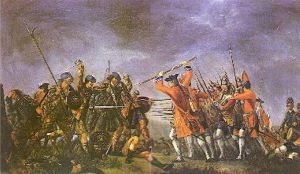 Whilst we arrived on the Monday for practical purposes our cruise started on the Tuesday morning after a leisurely breakfast on board and a short coach trip to the Culloden Battlefield and Visitor Centre.
Whilst we arrived on the Monday for practical purposes our cruise started on the Tuesday morning after a leisurely breakfast on board and a short coach trip to the Culloden Battlefield and Visitor Centre.
The 16 April 1746 was a gruesome day, well depicted in the immersive theatre. Not for the faint hearted. Our guide briefed us on the journey on the background to the battle, the last on British soil. During the week we were going to learn much about ‘Bonnie Prince Charlie’, whose sad journey was to end as a 74-year-old alcoholic in Rome. Culloden was one sided, the disciplined Hanoverian Government troops losing just 50 men, and the Jacobite/Stuart rebels perhaps up to 2,000. From the Visitor Centre it is a short 10-minute flat walk to the memorial stone cairn for the fallen, many of the clan chiefs and clan members noted on headstones, marking where they fell. For the losers the defeat was a disaster with land lost and the kilt banned. In 1822 Sir Walter Scott welcomed King George IV to Edinburgh wearing a kilt, which changed the status quo.
Later in the morning we made a short visit to the Clava Cairns, a Bronze Age burial site, 4,000 years old and predating Stonehenge by 1,500 years and more recently made famous in the TV series Outlander.
 Whilst we were away Lord of the Highlands started on its journey down the Caledonian Canal and our night stop at Fort Augustus half way. We rejoined the ship at Dochgarroch.
Whilst we were away Lord of the Highlands started on its journey down the Caledonian Canal and our night stop at Fort Augustus half way. We rejoined the ship at Dochgarroch.
The canal is something of a misnomer running some 60 miles from Inverness to Fort William. Only one third of the entire length is man-made, the rest being formed by Loch Dochfour, Loch Ness, Loch Oich, and Loch Lochy. These lochs are located in the Great Glen, on a geological fault in the Earth's crust. There are 29 locks including eight at Neptune's Staircase, four aqueducts and ten bridges in the course of the canal.
Created by the remarkable Scottish engineer Thomas Telford work started on construction in 1803 and it was finally opened in 1822. It is now recognised as an official Ancient Monument and is part of Scottish Canals. Our fascinating journey was to finish with a coach detour halfway down Neptune's Staircase series of locks to Glenfinnan where Bonnie Prince Charlie landed prior to his ultimate defeat at Culloden. Here there is also a remarkable single track railway viaduct of Harry Potter fame built at the end of the 19th century.
On the Wednesday we were to night stop in the final lock called Corpach Basin, before entering Loch Linnhe, a sea loch, and on towards Oban, home of sister ship Hebridean Princess and the end of the Glasgow railway.
Thursday night we docked soon after lunch at Dunstaffnage Marina, a 20-minute coach ride away from Oban, for once our timetable and that of the paddle ship Waverley clashing. We had to give precedence to the old lady (1947 built) pleasure steamer and make a road return journey. We had plenty of time to explore.
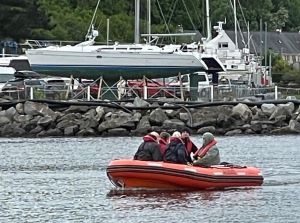 Oban is the capital of the Western Isles dominated by McCraig’s Folly built in 1897 by local banker John Stuart McCaig, the aim of the tower was to provide work for local stonemasons and a lasting monument to the McCaig family. It offers spectacular views across Oban Bay, the gardens inside the tower are well maintained and a peaceful escape from the hustle and bustle of town life in Oban. The walk up from the town centre takes 20 minutes.
Oban is the capital of the Western Isles dominated by McCraig’s Folly built in 1897 by local banker John Stuart McCaig, the aim of the tower was to provide work for local stonemasons and a lasting monument to the McCaig family. It offers spectacular views across Oban Bay, the gardens inside the tower are well maintained and a peaceful escape from the hustle and bustle of town life in Oban. The walk up from the town centre takes 20 minutes.
Friday morning and an early start and a post breakfast arrival at Craignure for a spectacular near 40-mile single track road coach ride with passing places to Fionnphort and the ferry for Iona, where St Columba landed in 563 bringing Christianity to Scotland. The modern Abbey dates from 1899. In June 2021, the Abbey reopened following a £3.75m renovation, fund-raised by the Iona Community over three years, and including a renewable energy system and high-speed broadband. We had lunch on the island and Hebridean even provided a taxi service for those who could not manage the under one mile walk from the quayside.
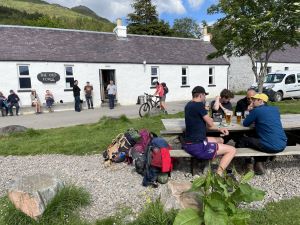 Next port was Tobermory where we were lucky that the main town quay was available for a night stop, the opportunity for guests (and some of the crew) to visit Misnish a popular local hostelry on the front. Those with children in the early 2000s may recall Balamory from a very popular TV series in which the brightly painted house featured.
Next port was Tobermory where we were lucky that the main town quay was available for a night stop, the opportunity for guests (and some of the crew) to visit Misnish a popular local hostelry on the front. Those with children in the early 2000s may recall Balamory from a very popular TV series in which the brightly painted house featured.
Saturday morning was spent exploring Tobermory and then away lunchtime for Inverie on Loch Nevis, a tiny waterside settlement with no road connection to any other UK mainland community. The ferry calls four times a day and the Old Forge pub is the most remote drinking place in Britain. A local ranger provided an interesting walk passing through several areas of regenerating native woodland, thanks to the Knoydart Forest Trust.
On Sunday it was an early start as we breakfast on our way to Armadale on the Isle of Skye and its ruined castle and fine gardens and the home of the Clan Donald centre. It was either a 10-minute walk or shuttle from the ship.
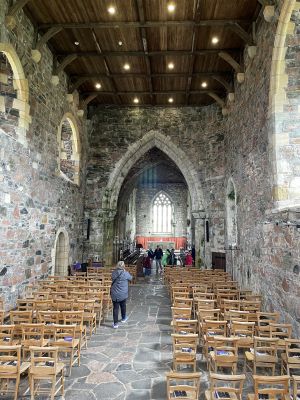 Again we were eating as Lord of the Highlands then made its way to our final port, Kyle of Lochalsh once the gateway to Skye, but since the opening of a bridge in 1995 now just the end of the railway line that connects via Inverness to Edinburgh and Glasgow. Also in the tiny port was Hebridean Princess for a rare meeting of sister ships and a chance to inspect a wonderful old lady not seen since 2002. She was immaculate. At Kyle of Lochalsh the tour was by bus to another famous castle and its grounds, the island fortress of Eilean Donan, once again the victim of the Jacobite uprising but now rebuilt in the early part of the last century and described as a "a rubbly Edwardian stage-set for life in the Middle Ages".
Again we were eating as Lord of the Highlands then made its way to our final port, Kyle of Lochalsh once the gateway to Skye, but since the opening of a bridge in 1995 now just the end of the railway line that connects via Inverness to Edinburgh and Glasgow. Also in the tiny port was Hebridean Princess for a rare meeting of sister ships and a chance to inspect a wonderful old lady not seen since 2002. She was immaculate. At Kyle of Lochalsh the tour was by bus to another famous castle and its grounds, the island fortress of Eilean Donan, once again the victim of the Jacobite uprising but now rebuilt in the early part of the last century and described as a "a rubbly Edwardian stage-set for life in the Middle Ages".
The Captain’s Farewell Dinner was a real Scottish affair with bagpipes and the traditional ode to the Haggis by Robert Burns, Scotland’s national bard. What a way to finish a wonderful week.
Next morning rising at the usual time for breakfast it was into a coach for the Hebridean holidaymakers with a spectacular two-hour Highland forest and lochs scenic coach ride to Inverness and either the railway station or airport.
How to describe the week. Truly outstanding, an insight into the history of Scotland, its wildlife, forestry, art and museums, with excellent company, looked after by an exceptional team dedicated to ensuring a trip to remember.
www.hebridean.co.uk/lord-of-the-highlands
Miles
From
To
Distance
Inverness
Fort Augustus
28
Fort Augustus
Corpach
24
Corpach
Dunstaffnage Marina
28
Craignure
Oban
9
Oban
Corpach
30
Corpach
Craignure
30
Craignure
Tobermory
17
Tobermory
Inverie
37
Inverie
Armadale
8
Armadale
Kyle
18
TOTAL MILAGE
229
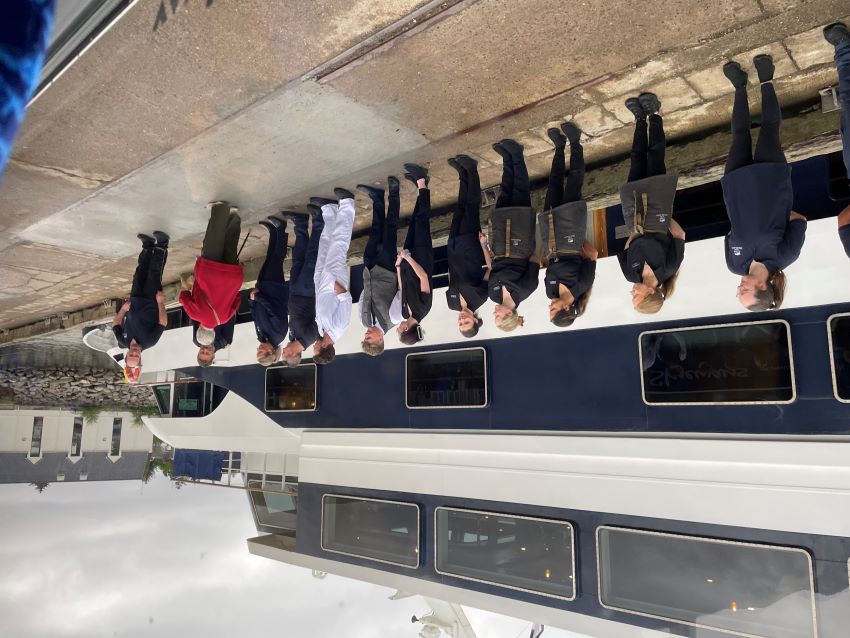
Not Downton Abbey. Guest Barbara James (90) of Burton Bradstock inspects the team before leaving for Inverness.
THE 2025 PROGRAME FOR HEBRIDEAN PRINCESS HAS BEEN ANNOUNCED
2025 will herald a return to the south coast of England for the Hebridean Princess, calling at Northern Ireland, the Isle of Man, Wales, and Lundy – all en-route from and to Oban. Based in Portland she will also be visiting the Channel Islands, the Isle of Wight, Northern France and the Isles of Scilly. Swansea also features as a departure point.
Three ‘Footloose’ walking cruises, in the home waters of the Hebrides out of Oban, feature alongside themed itineraries embracing the joys of gardens, arts and architecture, wildlife, distilleries and the best in Scottish food and drink. New for 2025 is the Hebridean Harmony cruise; accompanied by guest musician Will Marshall, guests will be entertained at various ports of call by local artistes and performers.
See also TNU April 2024 ON TOUR SPECIAL: In the footsteps of the Royal Yacht
and also Princess Anne & Hebridean.

A rare occurance. Hebridien Princess (left) and Hebridean Lord of the Highlands berthed at Kyle of Lochalsh.
This report was written and added to the Travel News Update website on board, effortlessly using the ship’s wi-fi which works well in all the cabins and public areas.
READERS' COMMENT
All comments are filtered to exclude any excesses but the Editor does not have to agree with what is being said. 200 words maximum
No one has commented yet, why don't you start the ball rolling?
Travel News Update
20 Lodge Close, Edgware HA8 4RL, United Kingdom
+44 (0)7973 210631
malcolm@ginsberg.co.uk
© 2023 Travel News Update Ltd
